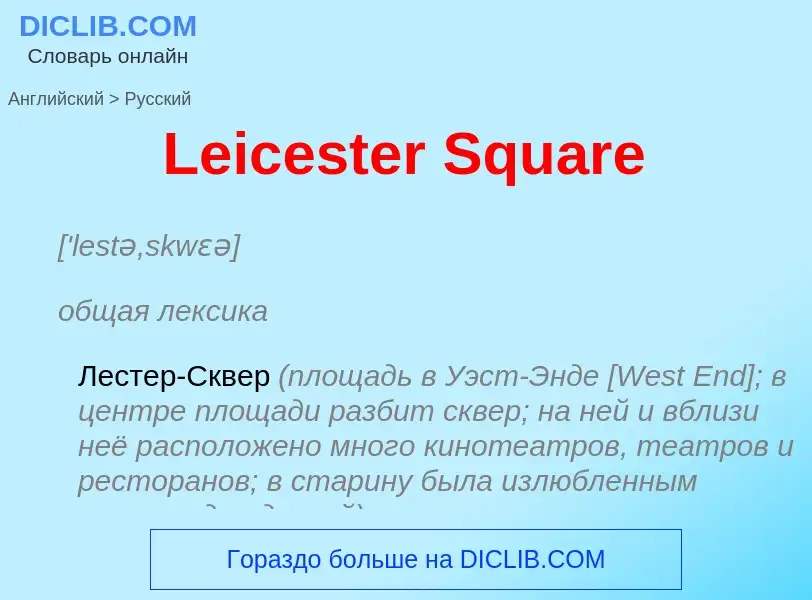Translation and analysis of words by ChatGPT artificial intelligence
On this page you can get a detailed analysis of a word or phrase, produced by the best artificial intelligence technology to date:
- how the word is used
- frequency of use
- it is used more often in oral or written speech
- word translation options
- usage examples (several phrases with translation)
- etymology
Leicester Square - translation to russian
['lestə,skwɛə]
общая лексика
Лестер-Сквер (площадь в Уэст-Энде [West End]; в центре площади разбит сквер; на ней и вблизи неё расположено много кинотеатров, театров и ресторанов; в старину была излюбленным местом для дуэлей)
['lestə]
общая лексика
лейстерская порода (мясо-шёрстных овец с длинной шерстью; разводится на севере Англии в графстве Лестершир)
лестерский сыр (мягкий, красноватого цвета)
лейстер
полное выражение
Leicester sheep
Leicester cheese; первоначально изготовлялся в графстве Лестершир
синоним
существительное
география
Лестер
сельское хозяйство
лейчестер (порода овец)
Definition
Wikipedia

Leicester Square ( (listen) LEST-ər) is a pedestrianised square in the West End of London, England. It was laid out in 1670 as Leicester Fields, which was named after the recently built Leicester House, itself named after Robert Sidney, 2nd Earl of Leicester.
The square was originally a gentrified residential area, with tenants including Frederick, Prince of Wales and the artists William Hogarth and Joshua Reynolds. It became more down-market in the late 18th century as Leicester House was demolished and retail developments took place, becoming a centre for entertainment. Several major theatres were built in the 19th century, which were converted to cinemas towards the middle of the next. Leicester Square is the location of nationally significant cinemas such as the Odeon Leicester Square, Empire, Leicester Square, which are often used for film premieres (and the now closed Odeon West End). The nearby Prince Charles Cinema is known for its screenings of cult films and marathon film runs. The square remains a tourist attraction which hosts events, including for the Chinese New Year.
The square has always had a park in its centre, which was originally Common land. The park's fortunes have varied over the centuries, reaching near dilapidation in the mid-19th century after changing ownership several times. It was restored under the direction of Albert Grant, which included the construction of four new statues and a fountain of William Shakespeare. The square was extensively refurbished and remodelled for the 2012 London Olympics at a cost of more than £15 million, taking over 17 months to complete.


![[[Charlie Chaplin]] statue [[Charlie Chaplin]] statue](https://commons.wikimedia.org/wiki/Special:FilePath/Charlie Chaplin-Leicester Square-London.jpg?width=200)

![Leicester Square looking north-west towards Swiss Court. The [[Lego]] store is visible to the left. Leicester Square looking north-west towards Swiss Court. The [[Lego]] store is visible to the left.](https://commons.wikimedia.org/wiki/Special:FilePath/Leicester Square in September 2016.jpg?width=200)
![Odeon Leicester Square]] in June 2006 Odeon Leicester Square]] in June 2006](https://commons.wikimedia.org/wiki/Special:FilePath/Londen 2006 (361) (2848925508).jpg?width=200)
![Panorama showing the Lego Store and [[M&M's World]] Panorama showing the Lego Store and [[M&M's World]]](https://commons.wikimedia.org/wiki/Special:FilePath/Panorama showing the Lego Store and M&M's world in Leicester Square, London.jpg?width=200)
![Mr. Bean]] statue in the square as part of the ''[[Scenes in the Square]]'' sculpture trail. Mr. Bean]] statue in the square as part of the ''[[Scenes in the Square]]'' sculpture trail.](https://commons.wikimedia.org/wiki/Special:FilePath/Statue of Mr. Bean at Leicester Square.jpg?width=200)
![West End]] besides being synonymous with London film premieres. West End]] besides being synonymous with London film premieres.](https://commons.wikimedia.org/wiki/Special:FilePath/Ticket Booth, Leicester Square W1 - geograph.org.uk - 1284462.jpg?width=200)


![James Walter Butler]] (1990)<br />Leicester, Hotel Street James Walter Butler]] (1990)<br />Leicester, Hotel Street](https://commons.wikimedia.org/wiki/Special:FilePath/Butler Leicester Seamstress front.jpg?width=200)


![Curve]] theatre Curve]] theatre](https://commons.wikimedia.org/wiki/Special:FilePath/Curve Leicester full panorama.jpg?width=200)
![[[Highcross Leicester]] shopping centre [[Highcross Leicester]] shopping centre](https://commons.wikimedia.org/wiki/Special:FilePath/Highcross Leicester.jpg?width=200)
![St Nicholas's Church]] and the [[Jewry Wall]]. St Nicholas's Church]] and the [[Jewry Wall]].](https://commons.wikimedia.org/wiki/Special:FilePath/Jewry Wall ruins Apr10.jpg?width=200)
![Abbey Park]] Abbey Park]]](https://commons.wikimedia.org/wiki/Special:FilePath/Leicester Abbey nave and cloister.jpg?width=200)
![Victoria Park]] Victoria Park]]](https://commons.wikimedia.org/wiki/Special:FilePath/Leicester Arch of Remembrance (front, 07) cropped.jpg?width=200)
![The interior of [[Leicester Cathedral]] The interior of [[Leicester Cathedral]]](https://commons.wikimedia.org/wiki/Special:FilePath/Leicester Cathedral Nave, Leicestershire, UK - Diliff.jpg?width=200)
![[[Leicester Cathedral]] [[Leicester Cathedral]]](https://commons.wikimedia.org/wiki/Special:FilePath/Leicester Cathedral panorama.jpg?width=200)
![[[Leicester Cathedral]] [[Leicester Cathedral]]](https://commons.wikimedia.org/wiki/Special:FilePath/Leicester Cathedral south facade.jpg?width=200)
![[[Leicester Guildhall]], dating from the 14th century [[Leicester Guildhall]], dating from the 14th century](https://commons.wikimedia.org/wiki/Special:FilePath/Leicester Guildhall.jpg?width=200)
![[[Leicester Market]] [[Leicester Market]]](https://commons.wikimedia.org/wiki/Special:FilePath/Leicester Market 2009.jpg?width=200)
![A6]] London Road. A6]] London Road.](https://commons.wikimedia.org/wiki/Special:FilePath/Leicester Railway Station from south.jpg?width=200)
![[[Leicester Town Hall]], completed in 1876 [[Leicester Town Hall]], completed in 1876](https://commons.wikimedia.org/wiki/Special:FilePath/Leicester Town Hall 13795509814 80de745302 o.jpg?width=200)
![Uganda Argus]]'' newspaper to discourage Ugandan Asians from settling in Leicester Uganda Argus]]'' newspaper to discourage Ugandan Asians from settling in Leicester](https://commons.wikimedia.org/wiki/Special:FilePath/Leicester city council advert on Ugandan Argus.jpg?width=200)
![[[Phoenix Square]] cinema and media complex [[Phoenix Square]] cinema and media complex](https://commons.wikimedia.org/wiki/Special:FilePath/Phoenix Square Leicester.jpg?width=200)



![[[King Power Stadium]], home of [[Leicester City]] [[King Power Stadium]], home of [[Leicester City]]](https://commons.wikimedia.org/wiki/Special:FilePath/WalkerStadium.jpg?width=200)
![[[Newarke Houses Museum]] (Grade II*) [[Newarke Houses Museum]] (Grade II*)](https://commons.wikimedia.org/wiki/Special:FilePath/Newarke Houses Museum Leicester.jpg?width=200)
![[[Jewry Wall Museum]] [[Jewry Wall Museum]]](https://commons.wikimedia.org/wiki/Special:FilePath/Jewry Wall and St Nicholas.jpg?width=200)
![[[Belgrave Hall]] [[Belgrave Hall]]](https://commons.wikimedia.org/wiki/Special:FilePath/Belgrave Hall Museum - geograph.org.uk - 70266.jpg?width=200)
![[[King Richard III Visitor Centre]] [[King Richard III Visitor Centre]]](https://commons.wikimedia.org/wiki/Special:FilePath/Dynasty Death and Discovery, Richard III museum entrance.png?width=200)
